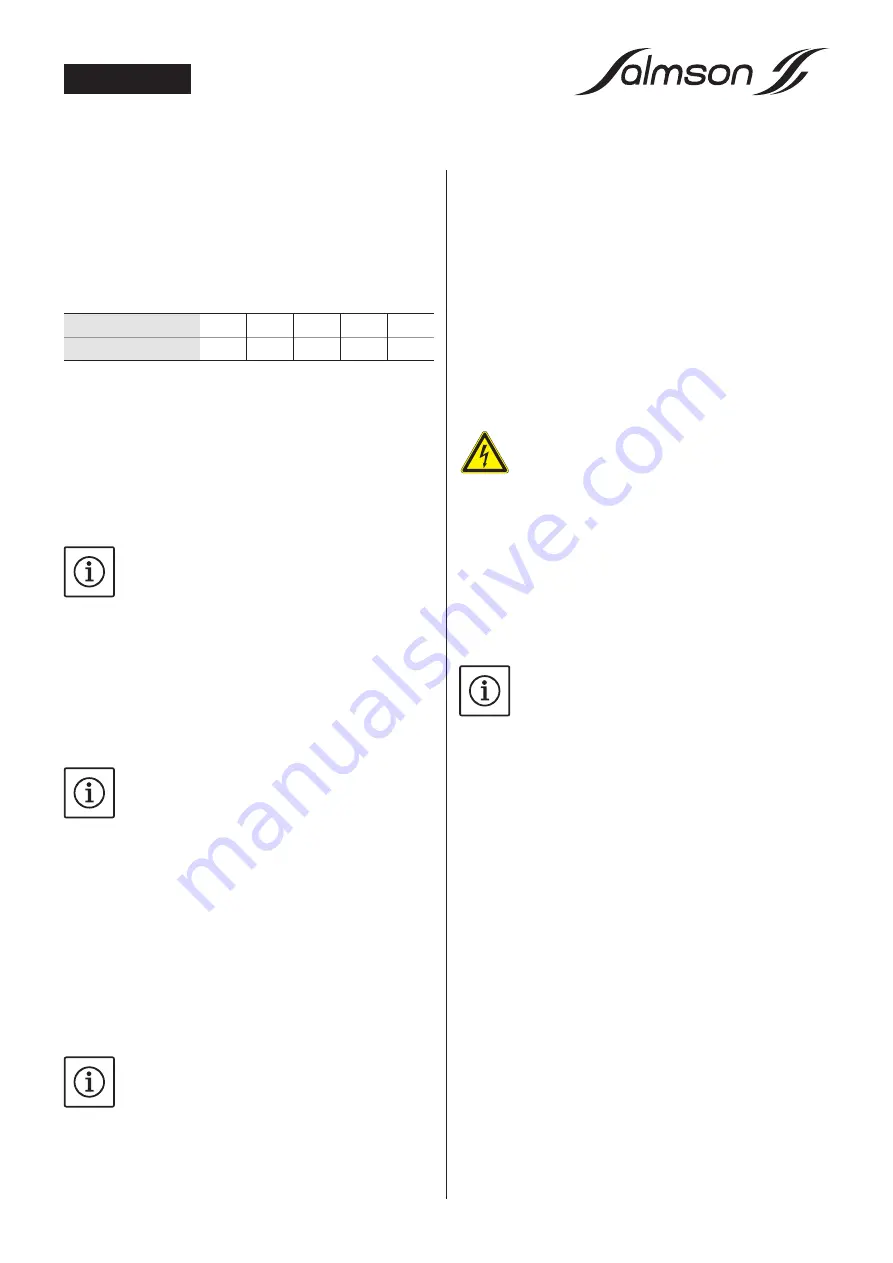
32
English
After each deactivation, the fault needs to be acknowledged via
the "Reset" button.
The motor protection needs to be set to the rated current shown
on the rating plate.
The desired rated current is set via DIP switches 1-5. The lowest
current value is 1.5 A where all DIP switches are set to "OFF" posi-
tion. On activating the individual DIP switches (ON position), the
current value is increased by the value of the relevant DIP switch.
DIP switch
1
2
3
4
5
Current value
0.5 A
1.0 A
2.0 A
3.0 A
4.0 A
Example: Required rated current 7.5 A
1.5 A + 2.0 A (DIP switch 3) + 4.0 A (DIP switch 5) = 7.5 A
5.4.3. Winding temperature monitoring connection
Bimetallic strips may be connected for temperature monitoring.
Monitoring is self-acknowledging, meaning that after the motor
has cooled down the error is reset automatically and the LED goes
off.
Connect the wires to terminals 1 and 2 (WSK) of the terminal strip.
NOTE
•
No external voltage may be applied!
•
On connecting a winding monitoring device, the fac-
tory converter bridge must be removed!
5.4.4. Connection for level detection signal transmitter
The level is detected using a float switch. Connection of level
sensors and electrodes is not possible!
Insert the cable ends of the cable laid onsite through the threaded
cable connections and secure accordingly.
Connect the wires to terminals 3 and 4 (GL) of the terminal strip.
NOTE
No external voltage may be applied!
5.4.5. High-water protection connection
A high-water alarm can be realized via a float switch. A visual
(LED) and audible (buzzer) warning are first emitted followed by
forced switch-on of the pump. The collective fault signal is also
active.
Monitoring is self-acknowledging, meaning that after the water
level has gone down the error is reset automatically and the LED
goes off.
Insert the cable ends of the cable laid onsite through the threaded
cable connections and secure accordingly.
Connect the wires at terminals 5 and 6 (HW) of the terminal strip.
NOTE
•
No external voltage may be applied!
•
We recommend high-water protection be provided as
additional fuse protection for the unit.
5.4.6. Collective fault signal connection
A potential-free contact is available via the corresponding termi-
nals for external signals (e.g. horn, flash light or alarm unit).
•
Contact: Changeover
•
Terminals: 7, 8, 9
•
Min. switching capacity: 12 VDC, 10 mA
•
Max. switching capacity: 250 VAC, 1 A
•
In case of an alarm, a drop in voltage and when the main
switch is switched off, the contact between terminals 8
and 9 is closed.
Insert the cable ends of the cable laid onsite through the threaded
cable connections and secure accordingly.
Connect the wires according to the required function at terminals
7, 8 and 9 of the terminal strip.
DAnGEr due to electrical voltage
An external voltage is applied at the terminals for
this function. This is also present at the terminals
when the main switch is switched off! there is a
risk of fatal injury! the power supply must be dis
-
connected from its source before all work!
5.4.7. Switching the buzzer on/off
When the buzzer is switched on, audible warnings are also emitted
in addition to the visual indicator.
The internal buzzer can be switched on/off via DIP switch 7:
•
"ON" position: Buzzer on
•
"OFF" position: Buzzer off (factory setting)
NOTE
If the battery for mains independent alarms is in-
stalled, the buzzer cannot be switched off via the DIP
switch during a power failure, when the main switch
is switched off or if the mains plug is pulled. To
deactivate the buzzer in this case, the battery must
always be removed!
5.4.8. Switching pump kick on/off
To prevent longer standstill times for the connected pump, a peri-
odical test run can be performed (pump kick function). A test run
of 2 s takes place after a standstill time for the connected pump
of 24 h.
The function can be switched on/off via DIP switch 6:
•
"ON" position: Pump kick on
•
"OFF" position: Pump kick off (factory setting)
5.4.9. Adjusting the follow-up time
Follow-up time is the time between the float switch "OFF" signal
and the pump being deactivated by the switchgear.
The follow-up time is continuously adjusted via the potentiome-
ter. Setting range:
•
Standard version: 0...120 s
•
Version S: 0...30 s
5.4.10. Installing the rechargeable battery
By inserting a rechargeable battery, alarm signals will be emitted
independent of the electricity network on power failure. An audi-
ble, constant tone will be emitted as an alarm.
1. Place the rechargeable battery in the holder. Pay attention
to the correct polarity.
















































